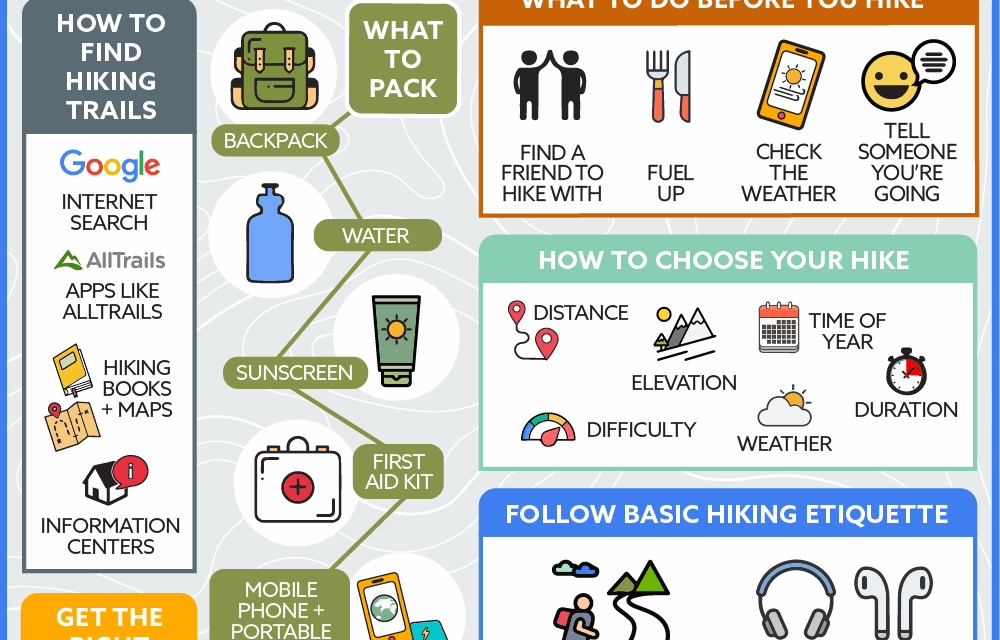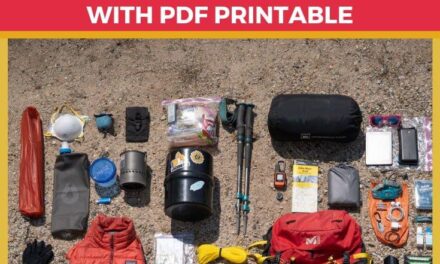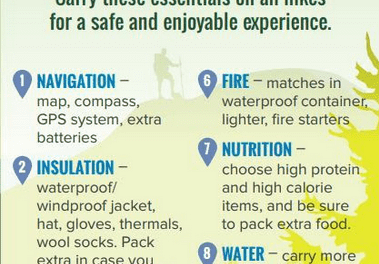Trail Safety Tips: A Comprehensive Guide to Safe Hiking for Families
Estimated reading time: 8 minutes
Table of Contents
Key Takeaways
- Prioritize staying on marked trails to prevent injuries and getting lost.
- Always communicate your hiking plans with someone outside your group for safety.
- Carry and familiarize yourself with a well-stocked first aid kit for emergencies.
- Proper planning, gear, and weather awareness significantly enhance trail safety.
- Follow trail signage and environmental guidelines to protect yourself and nature.
Introduction
Hiking is a wonderful way to explore the great outdoors, spend quality time with family, and enjoy the beauty of nature. As more families venture onto trails, it’s vital to prioritize safety to ensure an enjoyable experience for everyone. Recent statistics reveal that 20% of hiking fatalities are due to falls, while day hikers account for over 40% of search and rescue cases. Implementing trail safety tips noticeably reduces these risks and highlights the importance of preparation for a safe hiking adventure.
This guide covers essential safety tips, planning advice, and specific recommendations for hiking with kids so that families can hit the trails confidently. Whether you’re a novice adventurer or experienced hiker, these actionable insights will help you make the most of your outdoor experiences.
Essential Trail Safety Tips
Stay on Marked Trails
One of the most important trail safety tips is to stick to marked paths. Straying off established trails raises the risks of injuries and getting lost; according to Project Untethered, many hikers experience mishaps when they wander away from designated routes. By following marked trails, you can better navigate the landscape and enjoy the hike while minimizing hazards. For in-depth guidance on navigating challenging terrains, check out our detailed guide on the best hiking boots for rough terrain.
Inform Others of Your Hiking Plans
Always share your hiking itinerary with a friend or family member who will not be joining you on the trek. Provide them with estimated departure and return times, as well as the trail you intend to explore. This simple precaution can be lifesaving in case you encounter unexpected challenges; timely communication could make all the difference. You might also consider reviewing how to communicate effectively during outdoor adventures by exploring our guide on wilderness safety.
Carry a First Aid Kit
A well-stocked first aid kit is essential for every hiking adventure. Your kit should include:
- Adhesive bandages for minor cuts and scrapes
- Antiseptic wipes to clean wounds
- Pain relievers like ibuprofen or acetaminophen
- A gauze roll and medical tape
- Tweezers for splinters
Ensure you familiarize yourself with the contents of your first aid kit, particularly basic techniques, so you can handle minor injuries efficiently during your hike. To learn more about wilderness preparedness, see our comprehensive guide on survival skills for beginners.
Pack Adequate Provisions
Proper hydration and nourishment are crucial on the trails. Make sure to pack enough water to last through the hike, along with energy-boosting snacks like granola bars, nuts, or dried fruit. Additionally, remember to dress in layers appropriate for changing weather conditions, and don’t forget a lightweight rain jacket or windbreaker.
Monitor Weather Conditions
Weather can change rapidly, significantly affecting hiking safety. Research your trail’s forecast before your trip and pay attention to changing conditions throughout the day. Dangerous weather, such as thunderstorms or heavy rains, can make trails slippery and increase the risk of accidents. According to Jaynevy Tours, weather changes lead to numerous hiking accidents, emphasizing the importance of constantly monitoring conditions. To prepare for variable weather, review our tips on weather-aware hiking.
Follow Posted Safety Signage
While hiking, you will encounter various signs that provide important information about trail conditions, wildlife, and hazards. Pay attention to these signs and heed their recommendations. If a sign alerts you to loose rocks or hazardous areas, be cautious and adjust your path accordingly.
How to Plan a Hiking Trip
Research Suitable Trails
Before hitting the trails, research suitable hiking spots that match your group’s skill level and experience. Consider the length, elevation gain, and difficulty of the trail beforehand. You can refer to lists of the best day hikes in the US tailored for families, offering a selection of beginner-friendly and scenic trails.
Evaluate Weather Conditions
Always check the forecast during your trip preparation. The last thing you want is to be caught out in bad weather due to lack of planning. Assess how the day’s weather might influence your hike and adjust accordingly for a safer experience.
Gather Essential Hiking Gear
Compile a checklist of essential items to bring, such as:
- Map or hiking guidebook
- Navigation tools like a compass and GPS device
- Sufficient water and snacks
- First aid kit
- Weather-appropriate clothing
- Emergency whistle
Leave an Itinerary
Leaving your itinerary with a friend or at a ranger station helps ensure someone is aware of your plans. This is especially vital in case of emergencies. It provides peace of mind and aids rescuers in locating you quickly if needed. For more tips on trip communication, see our guide on wilderness safety.
Adjust for Children’s Needs
If you’re hiking with children, it’s essential to consider their needs. Choose kid-friendly trails that are short, well-marked, and feature interesting landmarks like rivers or scenic viewpoints. Ensure the pace is comfortable for everyone and take frequent breaks to make the hike enjoyable.
How to Avoid Getting Lost Hiking
Understand Trail Markers
Trail markers are essential visual cues guiding you along the intended path. Familiarize yourself with common marking systems used at your location, which often use colors or symbols to indicate different routes. These markers help prevent disorientation and keep you on track throughout your hike.
Use Navigation Tools
Enhance your navigation capabilities with technology. Apps like AllTrails and Gaia GPS allow you to access trail maps, track your progress, and download maps for offline use. However, don’t rely solely on your phone; having a backup navigation method such as a physical map and compass is always wise.
Carry Physical Maps
While digital tools are valuable, knowing how to read physical maps and use a compass is crucial if devices fail. Take the time to review the map before starting your hike to familiarize yourself with terrain features and landmarks.
Stick to Marked Trails
As mentioned previously, following marked trails is key to preventing loss. Avoid shortcuts or deviating from the established path, as this can lead to confusion and disorientation; safety always comes first.
Know When to Turn Back
Recognizing when it’s time to turn back is a vital skill. If the trail becomes too difficult, if weather worsens, or you stray far from your plan, don’t hesitate to retrace your steps. Your safety is the priority.
Hiking with Kids Safety Guide
Choose Kid-Friendly Trails
Select trails that are suitable for children, with minimal elevation gain and clear signage. Research the best day hikes in the US for families to find trails that are safe and engaging for young hikers.
Teach Kids Trail Etiquette
Educate your children about respectful trail behavior. Explain to them the importance of remaining quiet, yielding to others going uphill, and maintaining a safe distance from wildlife. Making these lessons fun and interactive encourages responsible outdoor conduct.
Use a Buddy System
Implement a buddy system especially with children. Pair them with adults or older siblings to ensure everyone stays together and safe. This practice fosters awareness and accountability among young hikers.
Pack for Kids Specifically
In addition to the standard gear, pack kid-specific items like snacks they enjoy, extra water, sunblock, and comfort items such as their favorite toys. Proper provisioning keeps children hydrated, comfortable, and happy during the hike.
Prepare Kids for Emergencies
Make sure your children know what to do if separated from the group. Teach them to stay calm, find a visible spot, and use a whistle if they have one to signal for help. This knowledge empowers them and prepares them for unforeseen situations.
Trail Etiquette and Environmental Responsibility
Respect Trail Rules
Each trail has its specific rules designed to ensure safety and conservation. Familiarize yourself with these guidelines, including leash regulations, camping areas, and fire restrictions, and adhere to them for a safe visit.
Give Way to Others
An essential part of hiking etiquette is yielding to uphill hikers. When on narrow paths, step aside to let those heading uphill pass. Doing so maintains trail harmony and safety for all users.
Wildlife Safety
Respect animals by observing from a distance and never approaching wildlife. Learn about local species and their behavior to avoid dangerous encounters and to help preserve their natural environment.
Practice Leave No Trace Principles
Adopt Leave No Trace practices to minimize your impact on the environment:
- Pack out all trash
- Respect wildlife habitats
- Stay on designated paths
- Minimize campfire impact
Conclusion
In conclusion, implementing trail safety tips is essential for enjoying a secure and memorable hiking experience. Whether you’re an experienced hiker or a family just starting out, these precautions significantly reduce risks and allow you to fully appreciate the beauty of nature.
As you prepare for your next outdoor adventure, remember to check out helpful resources such as hiking apps, local ranger stations, and community groups to enhance your safety and enjoyment. Get outside, stay safe, and embrace the journey!
Frequently Asked Questions
What are the most common hiking hazards and how can I prevent them?
The main hazards include falls, getting lost, weather changes, and wildlife encounters. To prevent these, always stay on marked trails, carry navigation tools, monitor weather forecasts, and maintain a safe distance from wildlife. Preparation and awareness are key.
How can I ensure my children stay safe while hiking?
Choose appropriate trails for their age, teach trail etiquette and emergency procedures, and keep a close eye on them through buddy systems. Packing essentials like snacks, water, and safety equipment also helps keep kids safe and happy during the hike.





